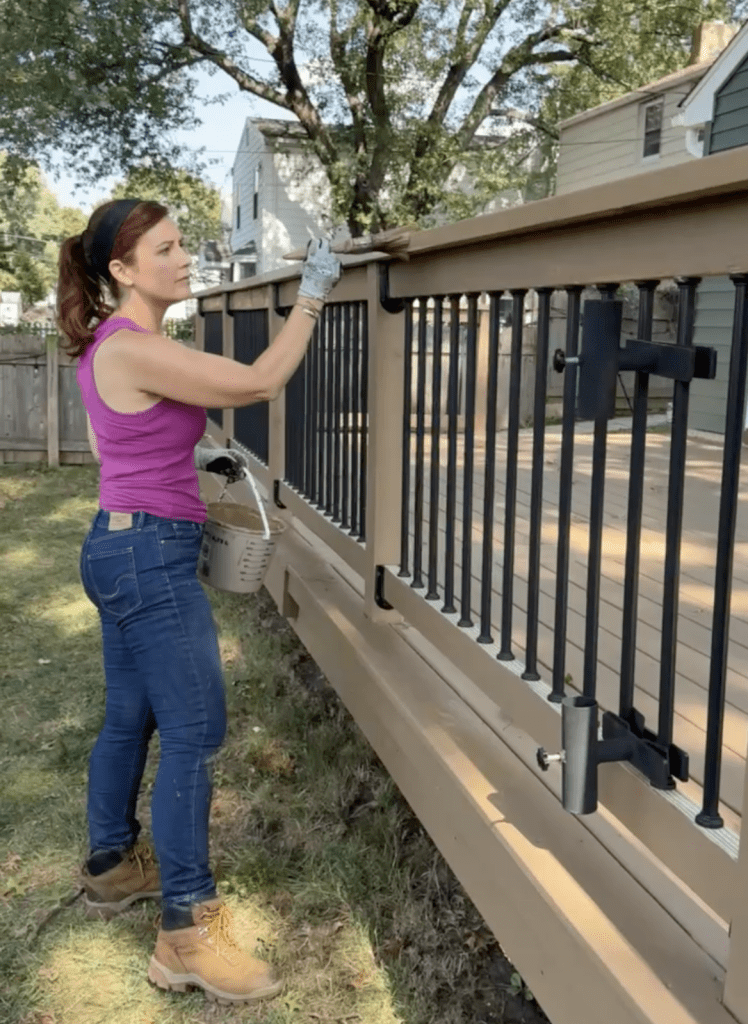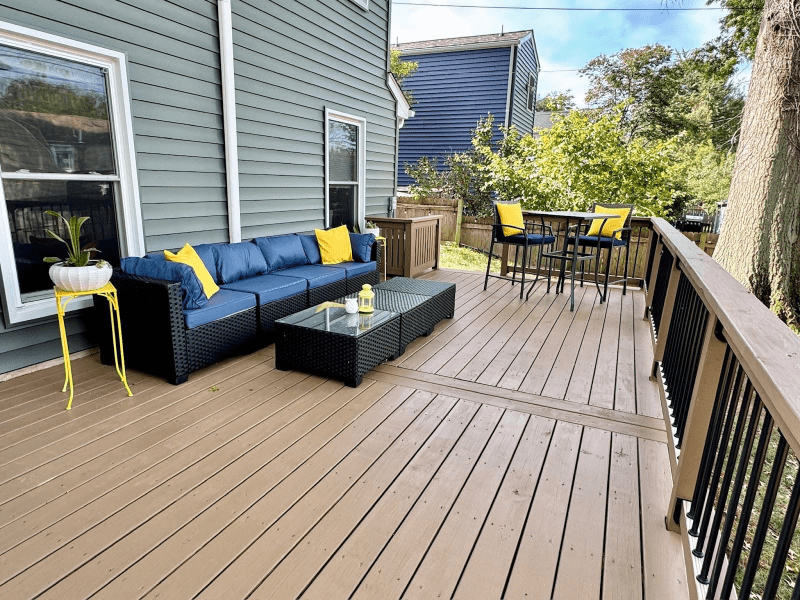
Staining a wood deck not only protects the wood, it’s also an opportunity to amp-up the aesthetic appeal of the entire backyard. We recommend staining during the early autumn days, since there’s less chance of rain than in the springtime, the temperature is more mild than summer, and it’s warmer than winter. Here’s how we stain a pressure treated wood deck using Cabot’s Solid Color Acrylic Stain + Sealer in Chestnut Brown.
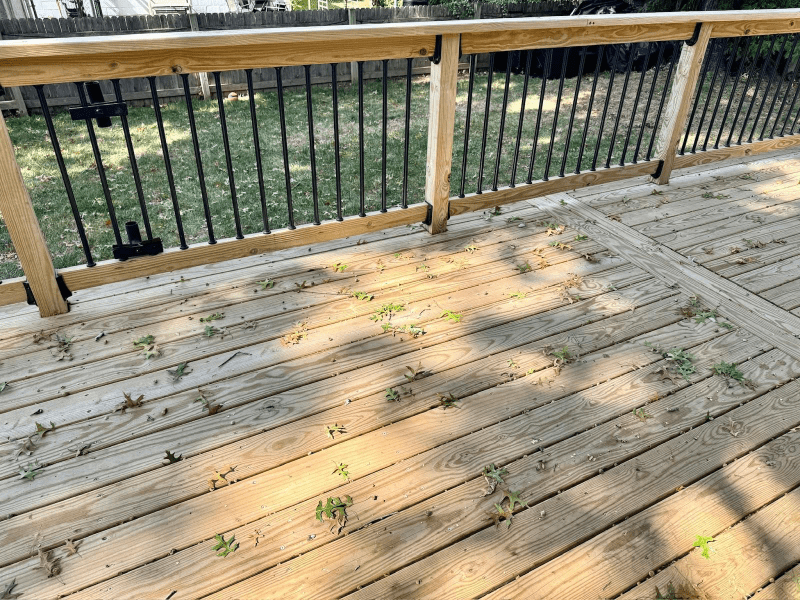
Before we cleaned and stained the deck. Yes, there’s a ton of organic matter falling from the trees that we needed to clean off the boards, and clean out from in-between the decking.
Why do pressure treated decks need stain?
We build a lot of pressure treated wood decks. And even though many may ask about composite decking during our initial meetings, most quickly decide on pressure treated (PT) wood because of how raging hot composite can get underfoot and that it’s triple the cost of PT.
Still, wood decks do need maintenance from time to time. They should be stained every 2 to 3 years to maximize their service life and awesomeness. So here’s what you need to know about staining a wood deck with Cabot’s Solid Color Acrylic Stain + Sealer.
When should I stain my wood deck?
Everybody wants their deck tuned up for summer fun. Makes sense. That makes springtime or early summer stain applications ideal, right? Sure, but where we live in the Northeast, it rains a lot in the spring. And you can’t coat water. And this year there was an excruciating July heat wave that we thought included a drying heat between torrents. It didn’t. So, we think autumn is ideal for staining a deck.
We like to stain the pressure treated decks we build in September. Sure, there are leaves falling, maybe some twigs and acorns, but the Cabot stain we’re using (A) doesn’t dry on the brush or board because the atmosphere is a broiler and (B) “skins up” fast enough that an acorn here or there can just be blown off. And, we can walk on it to get on and off the deck within reason.
Beyond the time of year, it’s important to time the deck stain based on the age of the deck. For a new deck, the Rule of Thumb is to wait 6 months after it’s built to coat with stain. We built this deck about a year ago. There’s no old coating to deal with. Removing an old coating is a different operation.
How long does it take to stain a wood deck?
If you paint a wall in your dining room and decide you don’t like it, it’s inconvenient. If you stain a pressure treated wood deck outside of the window of optimum weather conditions or your pets walk along in the wet stain, it’s not OK. It’s going sideways. The only way to rectify the situation is to sand, clean, and stain it again. Or you can live with the less-than-ideal stained deck and wait until it’s time to re-stain it next year or the year after.
This project can take a week of actual elapsed time.
Deck Staining Jargon
Many will talk about sealing a wood deck, but be careful about using that general term as there are various categories of deck sealers and stains. “Sealing” often refers to a clear coat and doesn’t mean stain. Since we are using a stain that has a color, we are staining the wood deck. Here are some more sealing and staining terms and concepts to know.
- The application of any fluid—including a “sealer”—to anything solid is called coating. This can be a verb or a noun. We apply a coating. We’re coating this deck with Cabot Solid Color Acrylic Stain + Sealer.
- There are a few basic categories of deck stain: Transparent, Semi-Transparent, Semi-Solid, and Solid. This refers to opacity, durability, and ease of use.
- Transparent gives wood a slight coloring, but it’s pretty close to clear.
- Semi-Transparent shows wood grain through a color tint.
- Semi-Solid will show some wood grain and needs to be applied more often.
- Solid stain is applied similarly to paint. Both are labeled as one-coat products.
Note: Cabot also offers DeckCorrect, which is designed to protect and surface-repair a damaged deck.
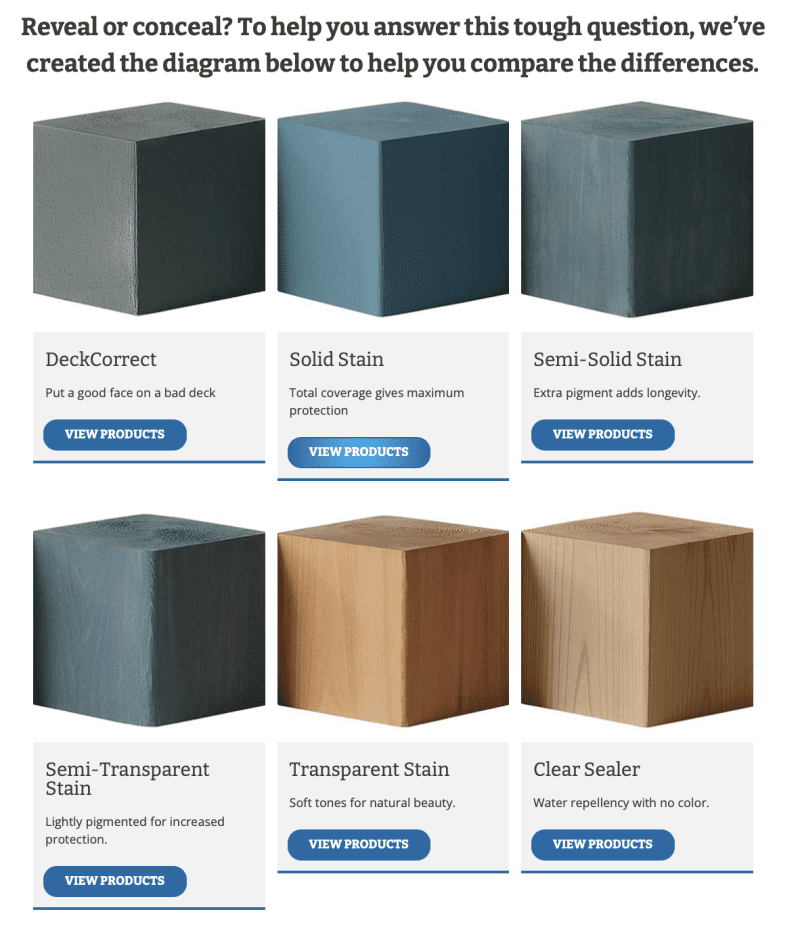
Prep: Staining Mindset and Cleaning
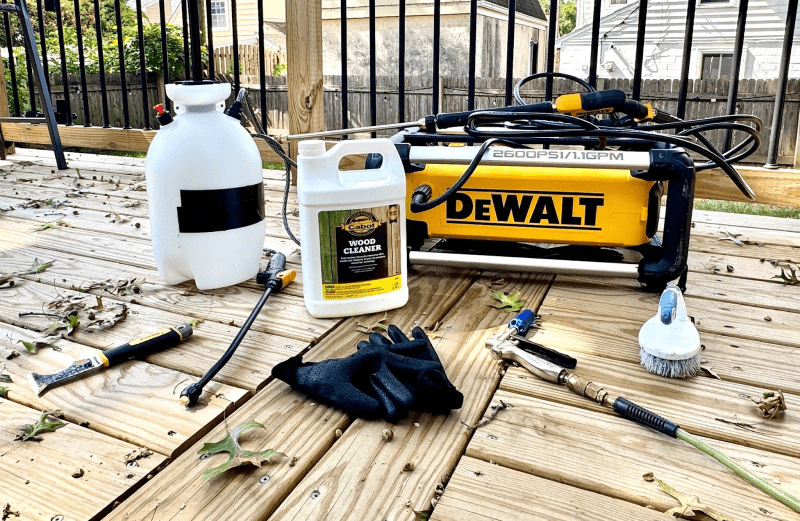
Before we can stain a deck, it needs to be properly cleaned. Here’s how we prep a deck for staining.
Be methodical
This isn’t rocket surgery, but there’s enough going on that doesn’t seem complicated until it is, moisture being chief among the complications. Make sure the deck surface is fully dry and there is ample dry time after application. If there’s moisture trapped under the stain, your coating may not succeed.
Cleaning tools
Cleaning a deck is pretty similar to soaking a dish in detergent before rinsing it off. The Cabot Wood Cleaner does the work and then we rinse it off.
If you think you can just use a pressure washer, think again. Pressure washers don’t clean anything. They are actually what we call “enhanced rinsing.” They also can open up wood fiber to accept a coating better. Like a light sanding, but with water. The Cleaner does most of the work.
- Deck cleaner can gray the wood out a little and smells a little bleachy. This is normal and won’t be seen through the stain.
- Deck brightener is a different animal and not something we’re using here.
How do I clean a wood deck?
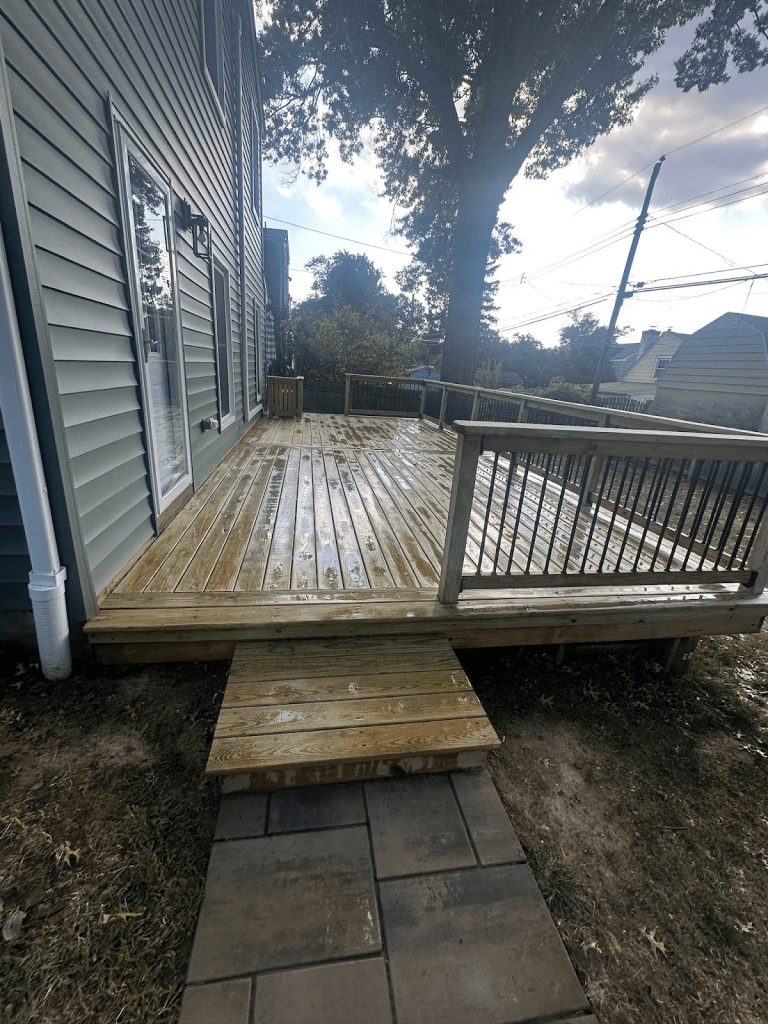
Cleaning a wood deck involves more than just spraying cleaner. There are a few more steps.
Pre-Cleaning
First, gouge out the twigs, leaves, maple doohickeys, and dog hair from between the boards. The Cleaner we used works great for the matter on the deck boards, but we also need to get the other stuff. For that, we like a combination of compressed air, the best-ever Kobalt blow gun and a Purdy 5-in-1 for this.
Deck Cleaner
This deck plus rails and band joists nets out to about 500 square feet. That’s about 3 gallons of deck cleaner. Every deck’s soil level is different, so we’ll say this: The detergent breaks down the dirt in layers. It works until it doesn’t, then you have to apply more. Keep the surface wet so the cleaner has time to do its work. We apply it several times.
Cleaning and Drying
We spray thoroughly, from left to right on about 1.5 boards at a time. Apply the cleaner and pressure wash to rinse. Wait at least 48 dry-weather hours before applying stain.
If it has been raining non-stop or humidity levels are high, wait longer than 48 hours. The cleaner works fine on wood with a high moisture content because it is working on breaking down dirt and other organics. The stain, however, needs to be applied when moisture content is stable.
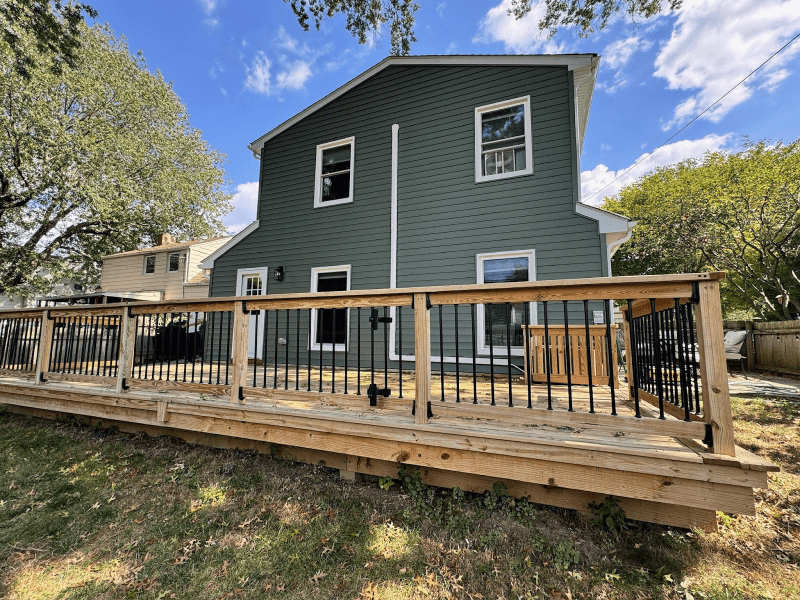
How do I stain a wood deck?
An excellent painter helped me develop this deck staining method for how to stain a pressure treated wood deck. Yeah, we kinda had the method, but we also plow snow, build custom fences, and design super-house projects. He really helped us clarify some details and pinch points so you can benefit from this crowd-sourced expertise.
- Make a “work center.” Place rubber pads, drop cloth, moving blanket, or plywood on the deck to stage your supplies. Choose something that spilled stain can’t drip through. Maybe set up a work table off the deck. We like my OmniTable Plus for this.
- Use a painter’s tool to open the stain can.
- If several cans are involved, mix them together in separate buckets so there’s no chance of color issues.
- There are a zillion products to make applying stain easier. Fine. We find brush-application the most dependable and highest quality. We use a 5-inch brush and squish all that goodness in the wood fibers we opened up with the pressure washer.
- We apply stain to 1 to 2 boards at a time, left to right and back. If decks have parting boards like ours do, we do that area last.
- Blotches can be repaired. Feather them out with sandpaper, then reapply stain.
- Have a plan to exit the deck if there are restrictions like height or egress to the yard that aren’t near where you’ve applied stain. For example, it might be easier to do the rail first, then work your way back toward the house
- We use a hardware system for the rail called DekPro that our friends at Niece Lumber sell us. It requires a fair bit of cutting in, like a painted room. Brush of choice for this: ¾-inch PF Richard cut-in brush. It’ll change your paint game like mad.
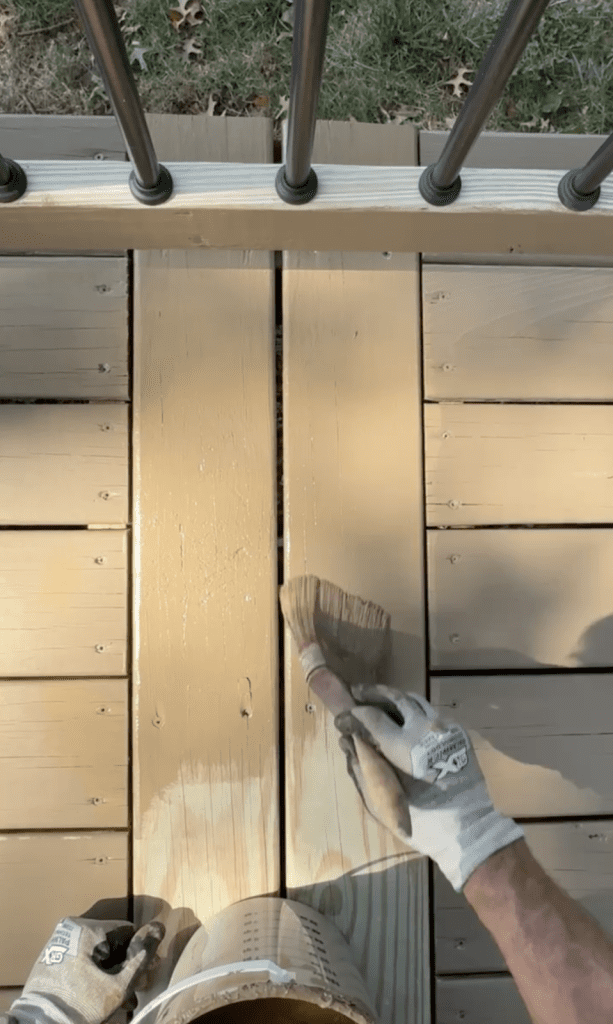
How long do I wait after stain is applied before I can use it?
When you stain a pressure treated wood deck, give the pets and the griddle and deck activity at least 24 to 48 hours before using it. The Cabot “skins up” fast and you can walk on it in about an hour, but heavy foot traffic, pets, parties, and furniture are a nope.
Wood Deck Staining Tips
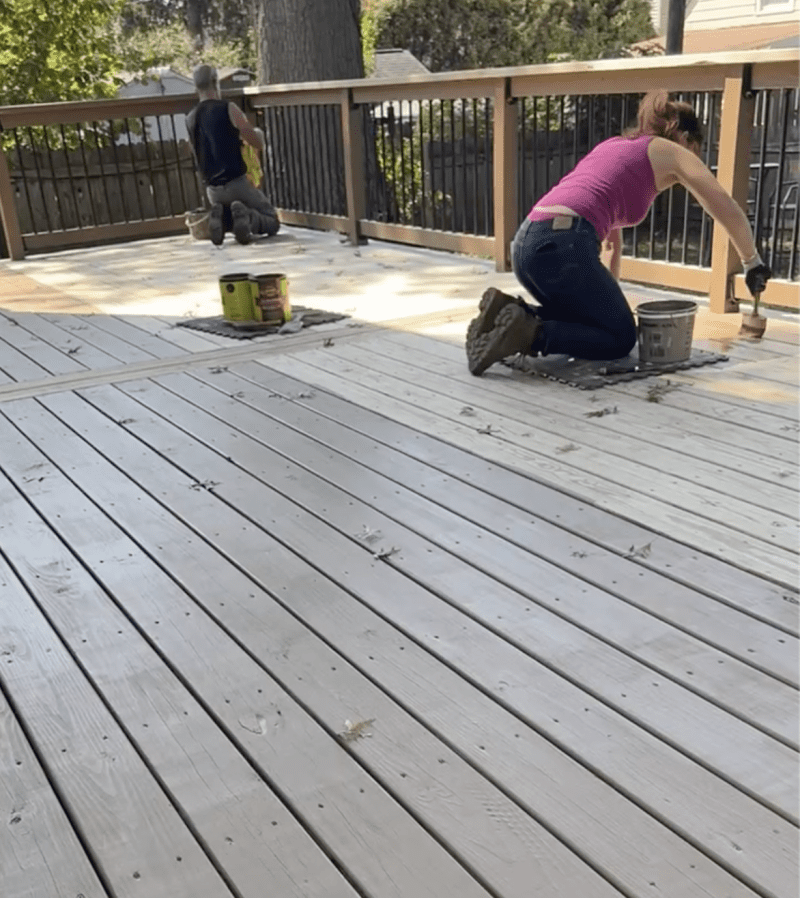
Here are some more tips for how to stain a pressure treated wood to help you achieve the perfect stain in your backyard.
Like Paint, But Not Paint.
Cabot’s Solid Color Acrylic Stain + Sealer behaves a lot like paint. But, it’s not paint. It’s thicker, heavier, and more viscous. It applies easily across a field of deck boards, but it takes some getting used to if you have to cut in, say, along a J-channel at the house. Our advice is to practice first and get a vibe for how you, the stain, and the brush you’re using interact.
No Silly Paint Brush Tricks.
Of the bajillion paint brush storage tricks I’ve seen–paint brushes in the refrigerator or wrapped in plastic over a lunch break– it’s orders of magnitude easier to just clean the brushes every few hours. Especially if it’s hot out. If you can manage staining a whole deck, cleaning a few brushes isn’t going to throw you.
Project Management.
This is not a “weekend” job. Sure, the actual application of the coating only takes a few hours, but the other externalities–sourcing product, cleaning, tool set-up and break down, finding weather windows, that wedding you super don’t want to go to, your Fantasy team, whatever–1-million percent does not fit into a “weekend.” Spread it out over a few weekends.
Here’s a cheat sheet to staining a deck:
- Source products first and get your supplies on site.
- Gather and organize tools: Brushes, 5-in-1s, pails, work center stuff, awl and hammer to pierce the gutter of the can. We like to have a water source at the ready just in case. And a damp rag will come in handy.
- Check the weather forecast frequently.
- Clean the deck and have an allowable dry time window. Apply stain
- Let the wood fully dry. Don’t risk applying stain on a moist deck.
- And don’t forget to wait a few days to enjoy your newly stained deck.
